People often opt to buy a purebred puppy, but many beautiful mixed-breed dogs make wonderful pets. One very large breed you may be considering is the Great Dane Labrador mix. Labradanes are lovable, affectionate, easy to train, and very large. Is this giant puppy right for you?
If you are bringing home a mixed-breed dog, it can be helpful to know the character traits of the parent breeds to understand what to expect. The Labradane is one of the more popular Labrador mixes due to Lab enthusiasts wanting to get a little bit of a size boost.
If you end up with a Great Dane Lab Mix, it is one that you might expect to be a very loving, smart cookie. They are also likely to be pretty big dogs that need a good amount of exercise.
Breed Histories
Before bringing home a Labradane puppy, you want to get to know both parent breeds. Your mixed-breed pup will inherit characteristics from each parent. While there is some unpredictability, looking at the parents can give you an idea of what your pup might be like.
Great Dane

The Great Dane didn’t originate in Denmark, as the name may lead you to believe. Instead, they are thought to have their roots in Germany. There is some argument amongst breed enthusiasts as to just how old the breed may be, with some claiming it to have a very ancient inception. Great Danes are believed to be closely related to English Mastiffs. They were originally bred to be formidable boar hunters. Their strength and size made them the ideal dogs for this task.
Of course, they are no longer associated with this type of work, and these hunting traits have generally long since been bred out of them. They are now commonly associated with being extremely affectionate companion animals. In fact, they are sometimes described as “Velcro dogs” because of how attached and needy they can be. Officially recognized by the American Kennel Club in 1887, they are a well-established breed. The Labradane is one of the more popular Great Dane Mixes.
Labrador Retriever

Like the Great Dane, the Labrador Retriever also has a name that would make you think they were associated with somewhere they are not. They did not originate specifically in Labrador, Canada, but rather in the linked region of Newfoundland. Labs were working dogs that were used to help fishermen in the area. They would help haul in the nets, retrieve escaped fish from the sea, and fetch ropes and other gear.
In the early 19th century, Labs were brought over from Canada to the UK, where they were developed as gun dogs. They were promoted as being excellent dogs for retrieving birds from the water. It was in England that their popularity and numbers grew, and this is where the breed was developed.
The American Kennel Club officially recognized them in 1917, so like the Great Dane, they are well established, and they are now one of the most popular breeds in the United States and the United Kingdom. Mostly, this is because of their generally affectionate, friendly, and intelligent personalities. They are also regularly used as service dogs for the same reasons.
Labs are commonly mixed with other breeds, like the Labrador Blue Heeler mix and the Husky Lab mix, which makes the Huskador.
Labradane Size & Appearance
A Great Dane Lab Mix is not guaranteed to look a certain way. Every mix will be an individual, depending on what genes they have picked up along the way. They may look a lot like one parent breed or may look nothing like either. A Labradane puppy may also change in appearance as they grow, so you honestly may not know what they fully look like until they reach adulthood.
Given the size of both breeds, it is a certainty that you will have a large dog. The smaller Labrador tends to weigh anything from around 50 to 80 pounds, and the Great Dane can be twice that weight, going up to as much as a whopping 200 pounds. A fully grown Labradane may weigh anywhere between 100 and 180 pounds. They stand between 24 and 30 inches tall from paw to shoulder.
The Labrador Retriever also tends to have two types within the breed. These are the show type and the working type. The show type is usually a bit heavier and broader, and the working type is typically built more athletically and often a bit longer in the leg. Depending on which type has been crossed with the Great Dane, this may impact their build somewhat.
Labradanes have a slender build, broad heads, and long floppy ears, taking after the Great Dane parent. The floppy ears can hang down the sides of the face, even past the cheeks. These pups have round, expressive eyes that can range from shades of blue to brown. They are big dogs but are not stout. They have an athletic, muscular build with a very tall profile. The tail is long and slender.
Coat & Color
Neither breed has a long coat, but they are quite different regarding their hair. The Great Dane’s coat is short and sleek, but the Lab has a very thick double coat Labradanes may have dense, short coats and shed regularly.
Labradanes can come in a wide range of colors but are often shades of brown and black. They can also be fawn, tan, yellow, merle, tricolored, and patchwork. A lot will depend on the colors and patterns of their parents.
Labs generally only come in three color types: black, chocolate, and yellow. Great Danes come in more colors, including brindle, black, fawn, grey/blue, merle, harlequin (which is white with black patches all over the body), and mantle (a black coat but with a white mask, neck, chest, parts of their legs and tip of their tail). So, there is a wide range of possibilities when it comes to the color and pattern of your Great Dane Lab mix’s coat.
Labradane Personality Traits
While every dog is an individual, it is very likely that you will have a very companionable, affectionate, and clever dog if you have a Great Dane Lab mix. Both breeds are known for sharing these qualities.
They both tend to be very gentle dogs that are good with children. Care should be taken around young children. Given their potential size and strength, Labradanes can easily knock over a toddler without meaning to. Even with the most tolerant dog, it is essential that children are also taught how to behave around dogs, how to care for them, and that they are taught to respect the dog’s space – no disturbing them while eating or sleeping.
Both parent breeds are very friendly and usually enjoy the company of visitors to their house. Great Danes can be known for being protective if the circumstance arises. If you do not want this behavior in your Labradane puppy, guarding behavior should not be encouraged. Instead, they should receive praise and rewards for calm, gentle greetings.
Labrador Great Dane mixes are more likely to give a very affectionate greeting. They tend to like the company of other four-legged friends. Because they are dogs that thrive a lot in company, they are often not suited to being left on their own too much and can develop separation anxiety. Labradanes can also develop low confidence, so they need heaps of praise and reinforcement for doing a good job.
Training
Both parent breeds are known for being people pleasers. They are usually highly motivated and eager to learn. Labradors are often the breed of choice for working as a service dog because of their ease of trainability and laid-back personalities. Mixing these two creates a very affectionate, eager-to-please dog. They love people, but because they are so big, Labradanes must be trained and socialized at a young age. Labradaanes can have very low confidence, meaning they can develop fearfulness of their surroundings, people, and even other dogs.
Without proper exercise, mental interaction, and stimulation, your Labradane may become a very clingy, destructive pup. If you plan to introduce a crate training regime, don’t forget you must have the space for a pretty big one.
Labradanes should have sufficient company, good walks, plenty of enrichment with interactive treat toys, and regular training sessions to prevent them from getting bored or stressed.
Labradane Training To Consider
Consider the following training tips for your Lab Great Dane mix.
1. No Jumping
Their general love of people means Great Dane Lab mixes can sometimes become over-exuberant in their greetings. Jumping up should be ignored, and you should only give them affection, attention, and reward when all four paws are on the floor. Given their potential size and strength, too much jumping up could cause them soreness. For little kids and people who are unsure about large dogs, jumping is potentially intimidating or even dangerous. You must start this training as soon as you observe jumping behavior.
2. Keep It Short & Simple
Labradanes do better with shorter, simple training sessions. Start with basic commands and obedience training. Once those are mastered, slowly introduce new training to boost their confidence. Start with the simple stuff, and keep the training session to between five and 15 minutes.
3. Positive Reinforcement
As with any dog, we always recommend using positive, force-free techniques when training your pup. Using aversive techniques that rely on fear and punishment can not only erode the bond of trust you have with your dog, but it can sometimes make the problem worse.
Positive reinforcement has been shown to be more effective than using aversives, as illustrated by this study published in the Journal of Veterinary Behavior. Because these pups can be so sensitive, they need positive reinforcement, and a lot of it. Consider a few sessions with an in-person trainer or an online training course if you are struggling to make progress with training your Labradane.
4. Avoid Off Leash Training
Off-leash training may be a stretch with this breed. They have a high chase drive and can cover a large distance in a short time. Labradors, in particular, have a hard time giving up a chase, and any breed mixed with them likely will have a strong urge to run after anything that moves. A fenced-in yard and long leashed walks are best for these pups.
Exercise
A Great Dane Lab Mix is not a breed suited to a sedentary lifestyle. They are both big, active, intelligent breeds that benefit from plenty of exercise and enrichment. Both from a working background they won’t do well in a small apartment with just one short walk. The Labrador Retriever, in particular, is a very active breed. They often thrive when participating in dog sports like agility, scent trials, and even Canicross (competitive running with your dog).
It is important to remember that large-breed dogs can take longer to mature than toy breeds, and you should not over-exercise a growing puppy. This can put too much strain on their growing bones and can cause musculoskeletal problems in the future.
Labradanes should be at least eighteen months to two years old before they start to do a lot of high-impact exercises like running or agility.
You should also be mindful of a Labrador’s innate desire to continue working when the weather is hot. They will often continue with the same intensity when playing and running. Labradanes can risk developing heat exhaustion if you do not step in and minimize the amount of time they exert themselves in hot temperatures.
Labradors are often prolific swimmers, and a Labradane puppy may enjoy a dip in the river, pool, or sea as an additional form of exercise.
Labradane Grooming
You are not going to have a dog that needs to go to the local grooming salon for a regular trim and pamper session with a Great Dane Lab mix. However, you are likely going to have to invest in a good vacuum cleaner, lint roller, and de-shedding tool. Labradors are notorious shedders, and even the Great Dane sheds a fair bit.
When they are going through a seasonal molt, you will likely have to give them a brush out every day to try to keep the hairs at bay, and other than that, they will need their short coats to be brushed at least once a week. This will help to remove any dead hair and keep their skin and coat in good condition. Don’t forget regular nail trimming and use dental treats or brush your pup’s teeth a few times a week.
If your dog inherits the Lab’s love of swimming, you may need to give them slightly more frequent baths. They can develop that infamous “wet dog smell” after too many dips in a stinky pond. They may inherit the Great Dane size and gangly legs. Make sure you have a suitable bathing space with plenty of non-slip mats.
If they are real water babies, it is also important to ensure that their ears are dried out properly after each swim, and they may need a cleanout occasionally with a good quality ear cleaner. Dogs that love to swim in dirty water are more prone to developing ear infections.
Labradane Health
Because they are larger dogs, Labradanes have a shorter lifespan, about eight to twelve years. Mixed-breed dogs tend to be healthier than their purebred parents but are still at risk for common health conditions. When it is a simple cross between two pedigree dogs, there is still a chance of them inheriting conditions from either mom or dad. If health checks have been done on the parents, then this will lessen the risk, but it is still important to be aware of what potential health conditions a Great Dane Lab mix can be prone to.
Because large breeds like the Labradane can be prone to a few different health conditions, you may want to consider pet insurance when your dog is young. Insurance can help cover the costs of emergency care, and some providers offer wellness plans that can help cover the cost of routine and preventative care. Pet insurance can help take away some of the financial stress during emergencies so you can focus on your dog’s care.
Great Dane Health Concerns
Bloat
Great Danes are very commonly associated with developing bloat or gastric torsion. Its medical name is Gastric Dilatation Volvulus (GDV). It is a condition that more often affects large breed dogs with deep chests. It is still a condition with many unknowns around it. Studies are ongoing to try to establish the exact causes.
What is known is that the stomach dilates and can twist. Bloat can cause problems with blood flow, breathing difficulty, and ruptures in the stomach. If immediate treatment is not sought, it can lead to death.
It is recommended that dogs are not fed one large meal per day. Split servings into two or three smaller meals to help minimize the chance of bloat developing. If your dog is a fast eater, using a slow feed bowl or feeding from a treat toy or snuffle mat may also be worth it.
Heart Disease
Great Danes are also commonly associated with developing dilated cardiomyopathy. This condition results in the heart muscles weakening and the inability to pump as effectively. If it is diagnosed early enough, it can sometimes be managed with medication, although it can eventually lead to heart failure and death. This condition often leads to a reduced life expectancy for Great Danes.
Other Health Concerns
They can also be prone to hip dysplasia, hypothyroidism (underactive thyroid), and bone cancer.
Labrador Retriever Health Concerns
Joint Problems
Like the Great Dane, Labradors can also be prone to hip and elbow dysplasia. They are also known for developing Osteochondrosis Dissecans (OCD), which impacts the cartilage growth in the joints and is often found in the elbows. They are also commonly associated with osteoarthritis as they age.
Progressive Retinal Atrophy (PRA)
PRA is a genetic condition that causes dogs to lose their eyesight gradually. It is not a treatable condition, although most dogs will still be able to have a high quality of life if they are supported in their adjustment to life as a blind dog.
Like the Great Dane, they can also be prone to bloat, although it is not quite as common. They are also more prone to epilepsy, dermatitis, and cataracts.
Hygromas
Both breeds, given their size and weight, can be more prone to developing hygromas. This is when a fluid-filled sac develops under the skin and around the joint area. It is usually on a bony promontory, and most commonly, it seems to be around the elbow joint. It is particularly common in Great Danes, especially as they age and become more sedentary. Although they are generally not painful, if they are left to grow too large, they can become infected or burst.
By providing a good quality bed for a large breed dog, you can help to minimize the chances of this developing. An orthopedic bed with a memory foam mattress that is big enough for your dog to lie out on fully can be a good investment.
Nutrition
There’s no other way to say this: a Great Dane Lab mix eats a ton. Given the size of both breeds, you must make sure you budget for their additional food requirements. They are much more expensive to feed than if you opted for a Yorkshire Terrier. Your pup will do better on a large or giant breed-specific dog food formula.
Labradors are known for being gluttons. They LOVE their food. This can mean that if they do not have an appropriately portion-controlled diet, then there is a risk that they could become obese quickly. This can put extra strain on their joints and can lead to a host of other health conditions. It is crucial that you continually and carefully monitor their food intake. You must also ensure that they get an appropriate amount of exercise.
Care must also be taken that, as a puppy, they are not fed food that is too calorie-dense. Large breed dogs that grow too quickly can develop musculoskeletal problems. Large-breed puppy foods usually have lower levels of fat, calcium, phosphorus, and vitamin D to support growth at a more appropriate rate than what they may have on standard puppy food.
Finding a Great Dane Lab Mix
The Labradane is not a recognized breed, so there will not be any registered accredited breeders. If you decide to get a puppy that is this mix, it is essential that you make sure that the breeder is a responsible one. You can expect to pay between $500 to $700 or more for a Labradane puppy, though the prices can vary depending on your area, the time of year, and the puppy’s pedigree.
You should be able to meet mom and her puppies in a stable and nurturing home environment. Look to see that they have already begun to receive early and appropriate socialization. Mom and pups should not be separated until they have been fully weaned and are at least eight weeks old. They should have had their initial health checks, too.
Don’t forget that there are so many deserving mixed-breed dogs, including Great Dane Lab Mixes, looking for homes in shelters across the country. Adopting a dog can be a hugely rewarding experience.
If you are looking for an affectionate, playful, energetic dog that thrives on company, humans, and dogs, then a Great Dane Lab Mix could be perfect for you.
Am I Ready For A Large Breed Dog?
Are you ready for a giant breed like the Labradane? If you are interested in getting a large breed dog, be sure that you have considered the additional feeding budget, the space needed, the extra exercise and care requirements, and the possible health problems, particularly those related to their joints. These giant pups need a lot of love and are much needier than one might think. They are much more expensive to care for overall than smaller dogs, so that must be a big consideration. Talk to your family members and make sure everyone is ready to take on this big, lovable pup.
Why Trust Love Your Dog?
Danielle is a dedicated pet owner with over three decades of experience. She has raised many different dogs, from very small five-pound Chihuahuas to 85-pound Labrador Retrievers. Each and every one of them has stolen her heart. Most of Danielle’s pets have been strays or rescues. She believes all pets are special and deserve to have a high-quality life and a safe home. Danielle is a dedicated researcher who spends countless hours reviewing the latest research and data in pet care, health, and products. She is devoted to bringing our readers the most current, up-to-date, and helpful information.
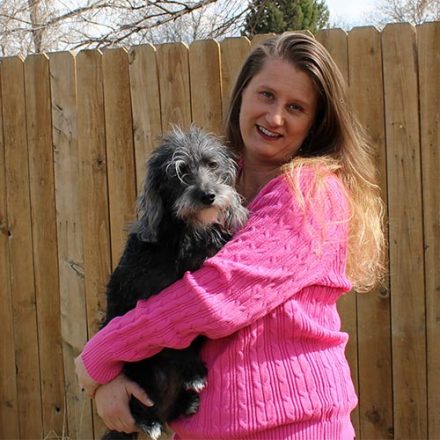

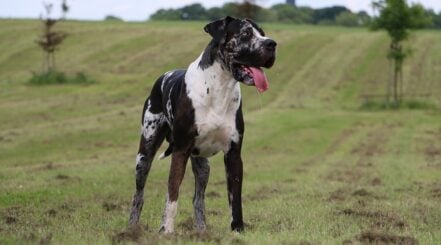
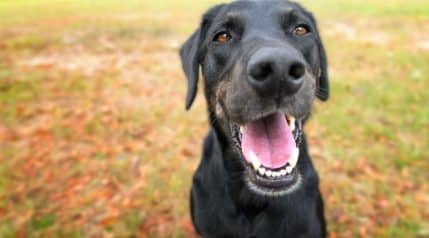
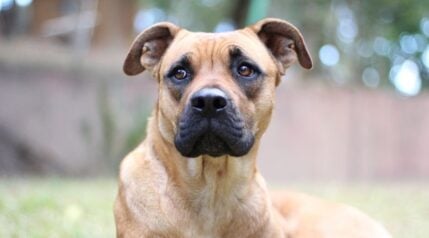
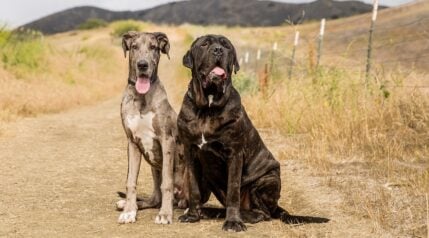
We have just lost our labradane, Monty. He was imported into Hong Kong aged 5 months and given up for adoption exactly a year later. He sat in SPCA for 4 months because he was too big for most people. We were leaving Hong Kong so we took him. He was aberrant and very destructive at first. However, he soon settled down to be a big gentle soul and great companion. We took him to Australia and then New Zealand. His heart gave up last weekend and we had to say goodbye. He was 13 and 3 months which is a good age for such a big dog. I would love to find another labradane but I guess they are only bred in the USA.
Jagger chose me at our local animal shelter. I say he chose me because I was not looking for such a large breed! Jagger is named after Mick Jagger…long legs, big mouth, very vain and he 💗 loves to sing. He is my gentle giant and he has brought me so much joy. When I adopted him at 1 years old he was almost full grown. I had no experience with such a large dog but found out quickly that Jagger’s heart was as big as was his size. I’m a professional personal chef and I travel the country with Jagger. We are currently in California, but our main base is Duluth, MN. He loves car rides,hiking, walks and of course he’s insane about swimming. His favorite buddy is Kizmet, an 80 pound Rottweiler that is sassy and must be in charge. Since Jagger has no desire to be the Alpha they make a great team. The love this dog has is immense and his ability to show it to the people in his life makes me a proud momma. I adore Jagger and believe I was blessed with both breeds!
We adopted our big boy about 6 years ago. We are his 3rd owners and somewhere along the way he had been disciplined harshly and developed some mistrust but has come a long way from that. Hes the most lovable, childlike big puppy we’ve ever had. He’s vocal and has a pretty large understanding of our vocabulary and will answer questions with barks, growls, lip-smacking and full-body wags. He loves people and is gentle around children.
But he also senses “bad people” and in a tense situation growled and charged a trespasser but I was still able to control him with voice commands. Hes been a delight to train but has a stubborn streak that shows occasionally. Hes so obedient and affable everyone who meets him wants our “Rowdy”.
Thanks for stopping by to comment, Tom! Sounds like you got lucky and adopted a wonderful dog! Dogs that have learned to communicate back to you are always fun. Thanks for sharing your story with our readers, and thank you for rescuing!
We lost our labradane last week from a blood disorder. We are heartbroken. Do you know where we might find another pup needing a loving home?
We love our LabraDane “Kilo” he weighs about 120 pounds and loves his food, he’s a sweetheart and very affectionate, tries to be a lap dog, enjoys our/his love seat to lay/sleep on sometimes, loves playing in and outside, going for a run daily when weather permits and while leashed to my power wheelchair.
We cruise at anywhere from 3-9 miles per hour, we likes car rides and going with us family, he’s a good all around love=able big fun dog, we’re very thankful we found him at the local animal shelter, a puppy at 8 weeks old, 1 of 8 in the litter, I kinda wish we would’ve gotten two puppy dogs 🙂
We took him to obedience school and that helped him and us a lot, we likes doing training for treats, we’re overall very happy we got him and love him dearly.
Thanks for the comment Matt! Seems like a fantastic pup!